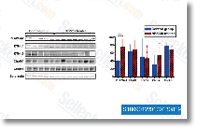Baccatin III is regarded to become the precursor of taxol. However the experiments with respective development in excess of a period of time did not display the anticipated precursor products rela tionship, The presence of high concentration of bacca tin III during the growth time period may as a result indicate that this molecule by itself is lively and may even have other roles. Further, the ester bond at C13 place of taxol is prone to be hydrolyzed for the duration of transport in to the cell and therefore yield a larger intracellular concentration of bacca tin III. Substantiating this hypothesis would clarify the greater efficacy of taxol. These research suggest to us that baccatin III is most likely the main energetic molecule within the cell and calls for investigation into its intracellular actions. In conclusion, this is certainly the initial report over the elucidation from the apoptotic mechanism of fungal baccatin III in cancer cell lines.
The question irrespective of whether taxol is a lot more energetic than baccatin III during the induction of apoptosis since the ester is readily transported while in the cell stays to be answered. As fungal baccatin III was identified for being much less active than fungal taxol from the in vitro studies, it is attainable that fungal taxol, apart from its microtubule binding kinetics and interactions with other proteins might have advantage more than baccatin III notably selleck chemicals inside the cellular uptake course of action. Infection by intracellular pathogens is demanding for the two the host likewise as the pathogen. The pathogen which encounters a adjust in pH, temperature, degrading enzymes and ROS, up regulates its heat shock protein repertoire post infection. Hsps are known antigens and lots of pathogen encoded Hsp60s and Hsp70s are vaccine candidates, Plasmodium falciparum causes cerebral malaria and one two million deaths annually.
Periodic fever is usually a hallmark of malaria exposing parasites to temperatures as high as 43 C while in the patient. Survival and proliferation in the parasite under such heat strain conditions Bortezomib has triggered interest in examining parasite Hsps. Earlier studies propose the parasite relies on its repertoire of Hsps, PfHsp90 specifically, to create and grow in the course of heat shock, These insights even so, are gleaned from studies on laboratory cultures on the parasite. The knowledge that exists with regards to the roles of parasite cha perones in contaminated sufferers is constrained towards the antigenic nature of parasite chaperone Hsp70 I. Hsp90 inhibition by geldanamycin in laboratory cul tures is demonstrated to become a successful system to inhibit parasite  development along with a derivative of this drug is in phase III clinical trials being a tumor inhibitor, Having said that, the importance of Hsps in field isolates will not be well explored. It truly is, for that reason, important to combine research from discipline isolates and laboratory strains to arrive at beneficial knowing of parasite growth and survival inside of the host.
development along with a derivative of this drug is in phase III clinical trials being a tumor inhibitor, Having said that, the importance of Hsps in field isolates will not be well explored. It truly is, for that reason, important to combine research from discipline isolates and laboratory strains to arrive at beneficial knowing of parasite growth and survival inside of the host.
ATPases Signal
Besides exchangers, other categories of transmembrane ATPase include co-transporters and pumps.
